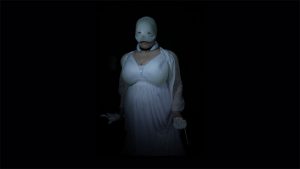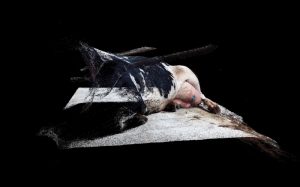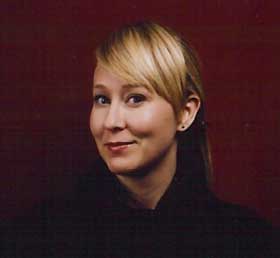 When i look back at the kind of projects i posted when i started this blog, two years ago, i sometimes cringe at my bad taste or feel sorry to see how much some works have been slipping into obsolescence. But in some cases, i dig up an old story and find out that it has lost none of its appeal and relevance. That’s exactly how i feel when i look at Alison Lewis‘s Masters Thesis at Parsons School of Design. Closer consists of a pullover and a jumper that respond to positive hugs, pats, and gentle touches with sound and light. She has also been involved in a great variety of projects such as magic bike (by Yury Gitman), Slopestyle (wireless interactive jackets by Moondial), the Spatial Narritive Displays at the Samsung Experience (work of Matthew Mohr), etc.
When i look back at the kind of projects i posted when i started this blog, two years ago, i sometimes cringe at my bad taste or feel sorry to see how much some works have been slipping into obsolescence. But in some cases, i dig up an old story and find out that it has lost none of its appeal and relevance. That’s exactly how i feel when i look at Alison Lewis‘s Masters Thesis at Parsons School of Design. Closer consists of a pullover and a jumper that respond to positive hugs, pats, and gentle touches with sound and light. She has also been involved in a great variety of projects such as magic bike (by Yury Gitman), Slopestyle (wireless interactive jackets by Moondial), the Spatial Narritive Displays at the Samsung Experience (work of Matthew Mohr), etc.
She’s now producing and hosting SWITCH, a brilliant online DIY show focusing on teaching young women about electronics through fashion and design.
Alison lives in New York where she works as as an interaction designer and part-time faculty at Parsons School of Design.
What i like so much about Closer is that one of the values these haptic responding sound garments aim to reinforce is kindness. A value one isn’t used to associate with electronics. Do you think it might change as people get more used to see their life invaded and mediated by technology? Have you heard about or seen any other project that deals with kindness?
First of all, thank you. I love your site and and feel honored to be interviewed.
Kindness is a value that’s hard to work with and probably will be something that I strive to represent and expand upon for a long time.
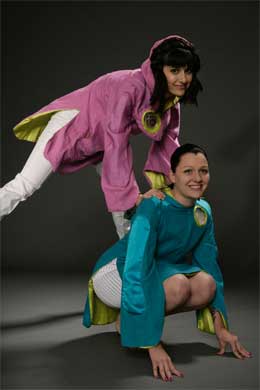 “True, kindness is not always a goal of technology but its there even if sometimes its inadvertent. Kindness is a part of us (hopefully) and is therefore a part of many of the technologies we create or use. Kindness is not hindered by technology, if anything we have more options than before or we may feel confused because the rules of interaction change. What was kind before is not always the case today or within our culture. Technologies change but the intention of kindness to another human being hopefully remains. For example, making a cross country phone call in 1920 is just as much a gesture of kindness as emailing to check on your friends health. I these cases, technology is just the tool or medium to accomplish these gestures.
“True, kindness is not always a goal of technology but its there even if sometimes its inadvertent. Kindness is a part of us (hopefully) and is therefore a part of many of the technologies we create or use. Kindness is not hindered by technology, if anything we have more options than before or we may feel confused because the rules of interaction change. What was kind before is not always the case today or within our culture. Technologies change but the intention of kindness to another human being hopefully remains. For example, making a cross country phone call in 1920 is just as much a gesture of kindness as emailing to check on your friends health. I these cases, technology is just the tool or medium to accomplish these gestures.
Something to ponder: “If we all had automatic doors, its possible the gesture of opening a door for someone may disappear, but what will come in its place? What will happen? Will the kindness disappear or just transform into another gesture?””
A project I am inspired by is Carrie Dashow’s 1 Million Hellos. She’s been saying hello to perfect strangers since 1999 and counting each one until she reaches 1 million. Of particular interest are her rules for what constitutes a Hello. The one that I find most important to the value of kindness is “No harboring ulterior motive.’
Another artist, Despina Papadopoulos, I talk about her later.
Have you tested the garments in “real life”? How was the experience like? Which feedback did you get from the testers/wearers?
Yes, I have. I wore them at the DT show and at Siggraph in the crowd. I have also watched peoples reactions to models wearing the garments. While these are both places where technology is appreciated it was not always a kind or comfortable experience. I had a man who wanted to hug me, but I didn’t want to hug him. There is a recap of the project coming out next spring in a special issue of The Senses & Society Journal called Re-mediating touch coming up in early 2007.
Can you imagine that Patsy or Filly could one day be sold in a fashion shop like a pair of Levi’s jeans?
As they are, no. They are fairly silly and I like them that way. But, I think the concept is suited for a child’s shirt or patch they can wear. Children are more open to the idea of hugging and don’t have issues of sexual desires, so it’s better for them. It is certainly doable. The only concern, as with all forms of touch, is they should be made so the wearer has the control of who touches them and it’s not just a random act. That is always the challenge with touch.
How should i call the field you’re working on? Techno-fashion? Wearable computing? Computational couture? Interactive fashion? Do these terms each relate to a different research?
This is a question in the field at the moment. I call what I have made, fashion-technology but appropriate term for the field maybe computational garments. I cannot speak for everyone, but most working in this area do not align themselves with the term Wearable Computing. Wearable computing, made popular by Steve Mann and Thad Starner, is generally described as a computer that “is always on and always accessible” (see Mann’s website) and are purposefully augmenting or task oriented like medical garments or military dress. While the disciplines overlap a good deal, I see computational designers focusing more on aesthetics and sociological and/or emotional concepts (closer to fashion theory and art).
For me, its not the textiles or the technology but the relationship of textiles to the body, the self and relationships that fascinates.
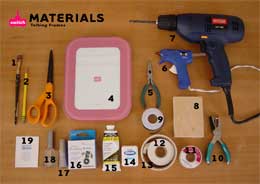 I sometimes have the feeling that the world of fashion technology (or whatever you choose to call it) is dominated by woman. Do men have a different approach to techno-fashion?
I sometimes have the feeling that the world of fashion technology (or whatever you choose to call it) is dominated by woman. Do men have a different approach to techno-fashion?
I can see why you think that. I think what’s happened is women’s history in crafts, homemaking and fashion design has heavily influenced the approach. At the same time there are many women in the fashion industry. Also, from what I’ve noticed the projects are usually socially and emotional based which are concepts associated with women. But if you look a little harder you’ll notice Issey Miyake and Hussein Chalayan in that group, and if I am not mistaken, they are men.
Are you a fashion victim?
Well, let me say this. I can’t afford a lot of things, but I always try to have at least one fabulous item a season. This Fall/Winter I have purchased the most perfect pair of kidskin Chanel ankle boots. They are high, tight, patent leather and remarkable. I barely wear them.
As a teacher of fashion theory and dress, this is what I should say:
1) I am a victim of trend (ankle boots)
2) I am a victim of wearing something uncomfortable for fashions sake
3) I am a victim of my own need to have a prescribed “unique” item in my wardrobe (a victim of my own identity)
4) I am a victim of industry pricing and buying into the “brand”
5) I am a victim of the idea of personal added value due to a monetary thing
But I don’t feel victimized. I feel strong, powerful and sexy.
 Alison and Diana Eng make a talking picture frame
Alison and Diana Eng make a talking picture frame
What motivated you to create Switch?
What motivated me to create SWITCH was the fact I missed out on learning this stuff as a girl and became empowered by it later. As a youth, technology was sold to me in the traditional homemaking sense. I could use a sewing machine, a blender and some tools (ask my dad about what I did to the back shed!) But electronics and technology wasn’t emphasized to me and society didn’t push me that way. I mean, no “cute” or “decent” girl in high school would dare take the drafting or shop class. That was social suicide. At the same time, I was uninspired by the projects I saw come out of the shop and mechanic classes. I was more interested in boys, fashions, my friends and my social life. I was a very “average” gal in that respect. Then, I got older and saw a show by Bill Viola, started doing drafting and websites. I became a technology lover and wanted to give back what I didn’t get. (obviously that is the very short version)
So, what drove me to do SWITCH was my past but its so much more. By incorporating the skills I’ve learned and the amazing people I meet doing this I hope to make technology accessible and approachable to a wide audience of girls and women.
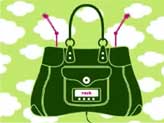 Do you think girls are still afraid of technology?
Do you think girls are still afraid of technology?
I don’t think girls are “afraid” of technology, what I think that in most cases it hasn’t been shared with them in a way they can relate too in order to inspire the desire to create with it. For SWITCH, a prototypical watcher is young, interested in fashion, values interpersonal relationships, and is fond of self-expression through creation. While she may or may not be technically knowledgeable, she is tech savvy and comfortable with electronic gadgets like cell phones, laptops, and MP3 players.
I want people to make what they want, and be inspired by what they can create. By the way, Patsy and Filly are possible for the advanced SWITCH audience.
Is Switch your own contribution to the craft trend?
There is definitely a craft trend and I happen to be right in the middle of it. My grandmother is a crafter and I don’t mind being called that, but there is a part of me that thinks people like to call it Craft because I am female and use some found objects. However, anyone that really knows me, knows I am a designer first and artist second. I am honored by all titles but it’s important to note that ideas and projects on SWITCH are rooted in the thoughtful design of objects. You can’t just throw technology together. Well, you can, but to make something usable and aesthetically pleasing its important to think about the principles of design and its process.
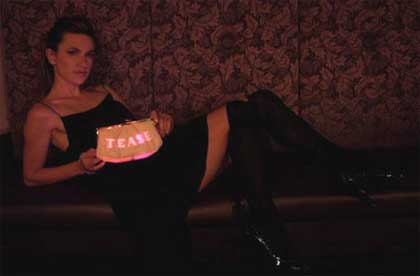 The Shiny Purse
The Shiny Purse
Can you tell us something about the SWITCH objects you presented at the Unravel show, the Shiny Purse and the Boom Box Beach Bag?
Both projects were done in collaboration with Fang-yu Lin, a friend and artist. Like all accessories they are fun, fashionable and expressive.
Shiny purse is a white purse with a text stencil on the inside. When you open the purse it lights up the interior to see your things AND the light shines through the stencil to show off a message. We used the word “TEASE” because we always want to leave people wanting more! The boom box beach bag is for the bathing suit beauty. It has removable speakers that snap on/off the beach bag. Plug in your MP3 Player and turn on the speakers and you’ve got a party on the go!
Both projects components are made from easily found materials so anyone can do them. Like hacking and refurbishing clothes, we’re re-mixing the purse and the bag with technology, upgrading (if you will.)
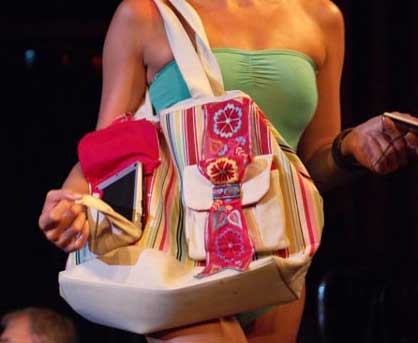 The Boom Box Beach Bag
The Boom Box Beach Bag
What are you working on now?
I just finished shooting a new show for SWITCH. It took a long while, but it’s done and should be up in December. I am sure any SWITCH fans are annoyed it took so long, but I hope they can forgive me. At the same time I’ve been researching funds and writing proposals for SWITCH and private projects. I wrote a very short recap of the Closer project for Berg Press’s The Senses & Society Journal called Re-mediating touch coming up in early 2007.
This January, I will be at the Australian University in Canberra at the reSkin Wearable Technology Lab working with 25 amazing designers and artists run by Elise Co and Joanna Berzowska among others. Our findings and projects will be presented at the WearNow Symposium on February 2-3, 2007. I also continue to teach at Parsons in both the Communication Design and Technology and Design and Management Departments.
Any artists or designers who work in the same field as you who should get more attention from the public?
Funny you should ask. About 4 years ago, I could name the people on one hand doing this work, now it growing and the people I’ve admired are getting attention.
There are so many people to share with you, but I picked the following three not only for their talent but their integrity and appreciation of the open and helpful community we are in.
Despina Papadopoulos: Despina brings a philosophy background to the fashion tech world. Like most of the people I admire, her work reflects a positive attitude towards technology. Some may begrudge designers for this, but her work reflects purpose and choice. The utopian or positive view is not done lightly or without understanding of life’s underbelly of negativity and sadness. She brings grace and intelligence to her work and the field by working with concepts of etherealism, kindness and identity.
Rachel Wingfield: What an absolutely beautiful approach to technology and light. I love every texture, shape and pattern and aspire to make something that beautiful yet simple. Wingfield to me has tapped into the perfect combination of form, function and aesthetics and I feel she is one of the best desiners/artists in this area.
Angel Chang: Angel is getting lots of press at the moment for her new collection, but when I first met her she was writing for French Vogue and hadn’t yet done her own line. The first reason I like her is because she is a true fashion designer, without the “its all about me” attitude. Angel’s work is well crafted, wearable and aesthetically pleasing. She has worked for some of the best designers and is versed in the desires of both the fashion industry and technology. She is working hard to bridge the gaps between the industries with her writing and approach to design. Among all this, I admire her effort, poise and impeccable skill.
I————–|
I could continue on for hours about the influence on the rise of fashion theory, social constructs of technology and their relationship to our sense of self and the body, but I’m tuckered out. Maybe we can keep that for another conversation
|————–|
So, let me leave you with this playful verse:
“I’d rather play at hug o’ war,
Where everyone hugs
Instead of tugs,
Where everyone giggles
And rolls on the rug,
Where everyone kisses,
And everyone grins,
And everyone cuddles,
And everyone wins…”
– Shel Silverstein, where the sidewalk ends.
Thanks Alison!
Image credits: shots of Closer and headshot by Kate Kurath



